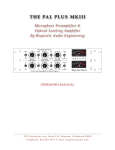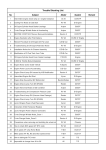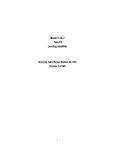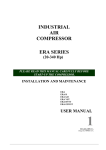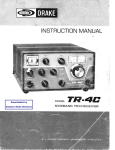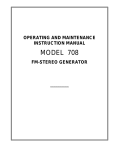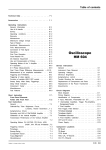Download Requisite Audio Engineering L2M MKIII M/S VERSION Operator`s manual
Transcript
THE L2M MKIII M/S VERSION O p t i c a l L e v e lin g A mp lifie r B y R eq ui site A u d io E n g in e e r in g OPERATOR’S MANUAL 2 1 7 5 G o o d y e a r Av e . , S u i t e 11 0 , S a n B u e n a Ve n t u r a , C a l i f o r n i a 9 3 0 0 3 t e l e p h o n e : 8 1 8 . 4 3 7 . 0 7 7 9 • w w w. r e q u i s i t e A u d i o . c o m THE L2M MKIII M/S VERSION TABLE OF CONTENTS INTRODUCTION 1 RECEIVING YOUR L2M 2 UNPACKING and INSPECTION: GENERAL NOTES 2 3 WARNING: 3 THIS SHIPMENT SHOULD INCLUDE: 3 SERVICING: 3 ENVIRONMENTAL CONSIDERATIONS: 3 FRONT PANEL CONTROLS (top & bottom rows) 4 IN/BYPASS 4 IN/BYPASS - OPERATIONAL NOTE: 4 OUTPUT LEVEL 4 OUTPUT LEVEL - OPERATIONAL NOTE: 4 OUTPUT LEVEL - CALIBRATION PROCEDURE: 4 FRONT PANEL CONTROLS (continued) 5 LIMITER FEEDBACK 5 LIMITER FEEDBACK - OPERATIONAL NOTE: 5 LIMITER RESPONSE 6 LIMITER RESPONSE - OPERATIONAL NOTE: 6 PEAK REDUCTION 6 PEAK REDUCTION - OPERATIONAL NOTE: 6 Requisite Audio Engineering L 2 M M k I I I M / S Ve r s i o n THE L2M MKIII M/S VERSION FRONT PANEL CONTROLS (center row) 7 MID 7 MID - OPERATIONAL NOTE: 7 SIDE 7 STEREO LEVEL RIDE 7 STEREO LEVEL RIDE - OPERATIONAL NOTE: 7 FRONT PANEL CONTROLS (center row- continued) 8 PK REDUCTION (MONO - LINK) 8 PK REDUCTION - OPERATIONAL NOTE: 8 METER SELECT 8 FRONT PANEL CALIBRATION POINTS 9 ZERO ADJ 9 ZERO ADJUST - OPERATIONAL NOTE: 9 GR TRACK 9 GR TRACK - CALIBRATION PROCEDURE: 9 FRONT PANEL CALIBRATION POINTS (continued) 10 VU ADJ 10 VU ADJ - CALIBRATION PROCEDURE: 10 STEREO ADJ 10 FRONT PANEL CALIBRATION POINTS (continued) 11 STEREO ADJ - CALIBRATION PROCEDURE: FRONT PANEL CALIBRATION POINTS (continued) STEREO ADJ - OPERATIONAL NOTE: Requisite Audio Engineering 11 12 12 L 2 M M k I I I M / S Ve r s i o n THE L2M MKIII M/S VERSION REAR PANEL (LEFT to RIGHT, top and bottom row) 13 GROUND 13 POWER SUPPLY INLET 13 AUDIO OUTPUTS 13 LIMITER LINK 13 TUBE CHANNEL 13 TUBE PLACEMENT and FUNCTION (left to right) 13 AUDIO INPUTS 13 OUTBOARD POWER SUPPLIES 14 POWER SUPPLIES 14 POWER ON 14 POWER CABLE 14 VOLTAGE SELECT 14 FUSE 14 WARRANTY Requisite Audio Engineering 15 L 2 M M k I I I M / S Ve r s i o n THE L2M MKIII M/S VERSION INTRODUCTION THANK YOU Thank you for selecting the L2M Mastering Limiter and thereby making it a part of your art. The L2M MkIII M/S Version is the third generation of our L2M platform, now in it’s 12th year of production (2011). We classify the L2M as a mastering limiter because it was designed with the specialized requirements of the mastering engineer in mind. Features such as a choice of outboard power supplies (all tube or solid-state), true bypass, 1dB 24-step attenuator, 1dB 10-step Limiter Feedback, Limiter Response, Mid/Side function, and multiple calibration points all contribute to its effectiveness in the demanding application of mastering. Furthermore, the L2M is equally at home in tracking and mixing situations. The L2M is an optical limiter based on classic designs of the early 1960s, however, the L2M is the beneficiary of many significant improvements and represents what a truly refined optical limiter can be. Among the more notable performance features of the L2M are it's sonic excellence, versatility and stable frequency response while limiting program material. Corrective EQ, following the L2M, is simply not required as with many limiters. Your work stays intact, just as you need it to. While providing unobtrusive compression/limiting action, there is no undulating bottom or loss of openness, even in the heaviest of limiting situations. For over a decade, the L2M has been installed in some of the finest mastering and recording studios throughout the U.S., Europe and Canada and has been the primary dynamics processor on many major record and film releases. Please read this manual carefully as it contains information essential to the proper operation of the unit. We welcome your comments and encourage you to write or call. Thank you again, and please enjoy! Danny “Sage” McKinney (Founder/President) Requisite Audio Engineering [email protected] 818.437.0779 R e q u i s i t e A u d i o E n g i n e e r i n g L2M MkIII 1 THE L2M MKIII M/S VERSION RECEIVING YOUR L2M UNPACKING and INSPECTION: Your shipment has been carefully inspected, checked and packaged at our company before being turned over to the carrier. We fully expect your L2M to arrive in your hands without having been harmed. However, at the point at which you do receive the product, it becomes your property. Therefore it is important that you carefully inspect the carton and it’s contents for any sign of physical damage which could have occurred in transit. Record and report any damages to the transportation company within 24-hours of the original shipment. Here’s what to do if the shipment has been damaged: Leave the product, its packing materials and box “as is.” Notify the carrier’s local office and request an immediate inspection of the shipment. After said inspection has been made and you have received written notification thereof, please contact our shop at 818.437.0779 for a return authorization number. We will repair or replace any damaged merchandise as necessary. Remember, it is your responsibility to follow the above procedures. Otherwise, the carrier will not honor your damage claim. If you have any questions regarding this notice or the shipment itself, please notify us immediately. Thank you, Requisite Audio Engineering 818.437.0779 R e q u i s i t e A u d i o E n g i n e e r i n g L2M MkIII 2 THE L2M MKIII M/S VERSION GENERAL NOTES WARNING: DO NOT OPEN THE CABINET - RISK OF SEVERE ELECTRICAL SHOCK THIS SHIPMENT SHOULD INCLUDE: Model L2M MkIII M/S Version Mastering Limiter Model OPS-2D Solid-State Power Supply or RTS-2A Tube Power Supply L2M Operator’s Manual (this book) A.C. Cable SERVICING: The user should not attempt to service this unit beyond that described in this manual. Internal voltage can exceed 350 VOLTS D.C. !!! Refer all servicing, other than tube and opto replacement to: REQUISITE AUDIO ENGINEERING 2175 Goodyear Ave., Suite 110 Ventura, CA 93003 • telephone: 818.437.0779 • email: [email protected] ENVIRONMENTAL CONSIDERATIONS: This and all electronic equipment require adequate ventilation and a dry environment for safe operation and long component life. If proper ventilation from behind the unit is provided, the L2M mainframe will require 4 rack spaces for mounting. If the RTS-2A tube supply is also used, it will require an additional 4 rack spaces (8 total). If using the OPS-2D (solid-state supply) it can be placed at the bottom of the rack, assuming reasonable ventilation. Do not allow either unit to become overheated. Also, while circuitry susceptible to hum pick-up is sufficiently shielded from moderate electromagnetic fields, installation should be planned to avoid mounting the system adjacent to power transformers, motors, etc. R e q u i s i t e A u d i o E n g i n e e r i n g L2M MkIII 3 THE L2M MKIII M/S VERSION FRONT PANEL CONTROLS (top & bottom rows) IN/BYPASS This switch (2 each) is a "true-hardwired" bypass, making a straight connection from input to output allowing for accurate comparison of source and processed audio. BYPASS will work, even if the L2M is off or unplugged from the A/C mains. IN/BYPASS - OPERATIONAL NOTE: For accurate perception when comparing processed audio to source material, it is essential that make-up gain be correctly adjusted. The L2M has 2 points to which MAKE-UP GAIN can be applied: OUTPUT LEVEL and LIMITER FEEDBACK. For more detail, see OPERATIONAL NOTES - OUTPUT LEVEL and OPERATIONAL NOTES - LIMITER FEEDBACK. For purposes of A/B listening STEREO LEVEL RIDE should be at it’s UNITY position. OUTPUT LEVEL Output level/make-up gain is accomplished using a precision 24-step attenuator (one for each channel). Range of settings is from -6dB to +17dB in 1dB increments. As an initial setting for the OUTPUT LEVEL attenuator, be sure the UNITY position is selected (both channels) and all other controls are in their “OFF or UNITY” position. Verify that switching between IN & BYPASS exhibits no change in volume. This can be confirmed by injecting a 1-kHz tone and observing an outboard DMM or other suitable meter. The L2M is shipped with UNITY calibrated to within .1dB. Each channel is calibrated by it’s respective UNITY ADJ on the back of the unit. OUTPUT LEVEL - OPERATIONAL NOTE: With program material being played, adjust the desired amount of PEAK REDUCTION and LIMITER RESPONSE. Referring to the loudest peak in the program material, note how much GAIN REDUCTION is occurring on the GR METER. Typical readings will be in the -3dB to -7dB range. Adjust the OUTPUT LEVEL attenuator to have the inverse amount of gain. As an example, if the GR METER is reading -5dB on the highest peaks adjust the OUTPUT ATTENUATOR to +5dB. Go to a quiet passage of the program material. Using the IN/BYPASS switch, you can now compare source and processed audio. OUTPUT LEVEL - CALIBRATION PROCEDURE: • Set PEAK REDUCTION & LIMITER RESPONSE fully-counterclockwise. • Set OUTPUT LEVEL, LIMITER FEEDBACK & STEREO LEVEL RIDE to UNITY. • Inject a +10dB 1-kHz tone. Verify using an external DMM or suitable meter. • Switch between IN and BYPASS. External meter should read the same or within .1dB • If not, adjust the UNITY trimmer (rear panel) until IN reads the same as BYPASS R e q u i s i t e A u d i o E n g i n e e r i n g L2M MkIII 4 THE L2M MKIII M/S VERSION FRONT PANEL CONTROLS (continued) LIMITER FEEDBACK Left to run freely, vacuum tubes are not linear and exhibit a considerable amount of harmonic generation and other forms of distortion. For over half a century, negative feedback has been engineered into circuits to “improve” the linearity of vacuum tubes when used in audio gain stages. However, best readings on a meter don’t always equate to the ideal sound, whatever that happens to be. By making LIMITER FEEDBACK an adjustable feature, harmonic content and texture are put into the hands of the audio engineer and not the guy with the THD meter. As an initial setting for the LIMITER FEEDBACK control, be sure the UNITY position is selected (Channel 1 & Channel 2). In order to maintain correct gain structure for accurate IN/BYPASS review, LIMITER FEEDBACK should be used in tandem with the OUTPUT LEVEL control. Since both OUTPUT LEVEL and LIMITER FEEDBACK are step attenuated in 1dB increments this is fairly easy to do. LIMITER FEEDBACK - OPERATIONAL NOTE: LIMITER FEEDBACK has a direct effect on the output level of the audio, which is why it is done in calibrated 1dB increments on the L2M. Because of this, proper setting of make-up gain is the combined settings for OUTPUT LEVEL and LIMITER FEEDBACK which should be set to the inverse of the GR METER reading. For example, a -5dB meter reading of PEAK REDUCTION would allow for a setting of +5dB on the OUTPUT LEVEL and a 0dB setting on LIMITER FEEDBACK. In this example, you would maintain UNITY and have the cleanest possible signal. In the same example, a -5dB meter reading of PEAK REDUCTION would allow for a setting of 0dB on the OUTPUT LEVEL and a +5dB setting on LIMITER FEEDBACK. In this example, you would maintain UNITY and add additional harmonics. Naturally, you could have +2dB on OUTPUT LEVEL and +3dB on LIMITER FEEDBACK. As an extreme example, -5dB of PEAK REDUCTION would allow for a setting of -5dB on the OUTPUT LEVEL with a +10dB on LIMITER FEEDBACK. With this setting, you would maintain UNITY and provide maximum harmonic generation, which can bring added “life” and “interest” to a dull sounding recording or be just the right texture for a lead vocal or guitar to stand out. Maybe, maybe not, it’s up to you. R e q u i s i t e A u d i o E n g i n e e r i n g L2M MkIII 5 THE L2M MKIII M/S VERSION FRONT PANEL CONTROLS (continued) RATIO 10:1 / 3:1 The purpose of this switch (Channel 1 & Channel 2) is to allow selection of either compressor (3:1) or limiter (10:1). Compression (3:1) occurs from the breakaway point (-30dB input). In the 10:1 position, the L2M operates as a compressor until it reaches the -20dB point then rolls-over into limiting action. Thus, combining the characteristics of a compressor and a limiter in the 10:1 mode. LIMITER RESPONSE With LIMITER RESPONSE (both channels) set fully counter-clockwise, the L2M will provide equal compression/limiting at all frequencies by responding to the entire spectrum of the program material. When LIMITER RESPONSE is set fully clockwise, frequencies below 1-kHz gradually require more energy to initiate gain reduction. For frequencies below 100Hz, gain reduction initiation is down approximately 10dB. This arrangement is ideal for general program material & especially material with a great deal of bass energy and/or broad bass dynamics. The result is a marked smoothing of mid and high frequencies (above 1-kHz) and a tight and punchy bass response. LIMITER RESPONSE - OPERATIONAL NOTE: For uniform limiter initiation and response in MONO or LINK mode, both channels require LIMITER RESPONSE to be at the same setting. This is also applies to PEAK REDUCTION. PEAK REDUCTION Set fully counter-clockwise, the L2M exhibits no gain reduction and acts as a line amplifier. Turning PEAK REDUCTION (Channel 1 & Channel 2) clockwise will gradually increase gain reduction. PEAK REDUCTION should be set for the desired amount of gain reduction as indicated on the VU meter while in the GR (GAIN REDUCTION) mode. A reading of -3dB to -7dB during the highest peaks of the program material is a reasonable range to work within, however, you are encouraged to experiment. PEAK REDUCTION - OPERATIONAL NOTE: Additional PEAK REDUCTION may be needed to offset the reduction in limiting action that occurs as you increase the setting of the LIMITER RESPONSE. For uniform limiter initiation and response in MONO or LINK mode, both channels require PEAK REDUCTION to be at the same setting. This is also applies to LIMITER RESPONSE. R e q u i s i t e A u d i o E n g i n e e r i n g L2M MkIII 6 THE L2M MKIII M/S VERSION FRONT PANEL CONTROLS (center row) MID With the MID control pulled out and in the fully-clockwise position, center is normal. Fullycounterclockwise Mid disappears. At the 12 o’clock position 3-4dB of make-up gain will be required to compensate for loss. MID - OPERATIONAL NOTE: MID-SIDE on the L2M is musically effective for tracks containing material recorded using stereo microphones. As an example, stereo drum overheads, stereo background vocals, room mics. The stereo output of a chorus pedal or stereo keyboard are not going to be effected in the same manner. For initiating Mid/Side functions the MID control must be in the OUT or PULLED position. With the MID control pushed “IN” MID-SIDE is fully disengaged. SIDE When the SIDE control is at it’s fully-counterclockwise position, left is left and right is right (L/ R). At the 12 o’clock position, both left and right are in center (mono). At it’s fully-clockwise position the image is “flipped”, left is on the right and right is on the left (R/L). The side control is continuously variable and adjusted in conjunction with the MID control. STEREO LEVEL RIDE Manual fine adjustment of level is a useful holdover from the old-school of mastering and is a good way to go when wanting to avoid level changes in the digital domain. Having a total range of 6dB, STEREO LEVEL RIDE is ideal for manual adjustment of level transitions from various sections of the program material. Stereo tracking of this dual-ganged pot is extremely accurate and holds a tolerance within 0.2dB throughout it’s entire range. STEREO LEVEL RIDE - OPERATIONAL NOTE: If needing to adjust track level both up and down, use the -3dB point as your average level, this will allow for increase or decrease of level as needed. R e q u i s i t e A u d i o E n g i n e e r i n g L2M MkIII 7 THE L2M MKIII M/S VERSION FRONT PANEL CONTROLS (center row- continued) PK REDUCTION (MONO - LINK) When operating in stereo or multi-channel mode, there is the option to LINK the triggering action of each channel. The PK REDUCTION mode switch can be used for MONO or LINK operation. It is also connected to the LINK jacks (found on the real panel) for interconnection of additional L2M units (5.1) or external triggering of limiting action. PK REDUCTION - OPERATIONAL NOTE: Though it is customary to LINK when processing stereo material, keep in mind that the forgiving nature of the optical attenuators found in the L2M allows for mono operation when processing most stereo material. We encourage experimentation in this regard. LINK allows each channel to “see” what the other channel “sees”. LINK does not link parameters. In other words, when processing stereo material, be sure to adjust the controls of both channels to identical settings. In link mode, a single PEAK REDUCTION knob can initiate gain reduction in both channels, however, you will not be able to get balanced LIMITER RESPONSE or RATIO without both channel’s controls adjusted to the same settings. METER SELECT GR/+4/+10 Meter Mode Select - When METER SELECT is placed in the GR position, the meter will indicate the amount of gain reduction and/or peak limiting in -dB. The meter is calibrated (see ZERO ADJ CALIBRATION) to read 100% or 0dB during periods of no gain reduction. When the selector switch is placed in the +4 position, the VU meter will indicate the balanced output level (post gain reduction) as 0 = +4dBu (0.775v). When the selector switch is placed in the +10 position, the VU meter will indicate the balanced output level (post gain reduction) as 0 = +10dBu (2.45V). R e q u i s i t e A u d i o E n g i n e e r i n g L2M MkIII 8 THE L2M MKIII M/S VERSION FRONT PANEL CALIBRATION POINTS ZERO ADJ The ZERO ADJ trimmer (2 each) is used to adjust the meter while in the GR (Gain Reduction) mode. When METER SELECT is placed in the GR position, the meter should read 100% or 0dB during periods of no gain reduction, indicating no PEAK REDUCTION is occurring. ZERO ADJUST - OPERATIONAL NOTE: Before determining that adjustments are necessary, be sure to allow 10 minutes of system warmup time and at least 5 minutes rest from any peak reduction activity. Also, be sure the METER SELECT is in the GR position. GR TRACK The GR TRACK trimmer (2 each) is used to adjust the tracking accuracy of the GR METER relative to the amount of GAIN REDUCTION that is occurring in the audio. GR TRACK - CALIBRATION PROCEDURE: • Allow 10 minutes of system warm-up time and 1 minute rest from peak reduction activity. • Set PEAK REDUCTION & LIMITER RESPONSE fully-counterclockwise. • Set OUTPUT LEVEL, LIMITER FEEDBACK & STEREO LEVEL RIDE to UNITY. • Set RATIO to 3:1 and IN/BYPASS to IN • Determine that ZERO ADJUST has been made (see above). • Inject a +10dB 1-kHz tone (2.45V). Verify level using an external DMM or suitable meter. • Select +10 on the METER SELECT and observe that the VU METER reads 0dB. • If VU METER does not show 0dB in the +10 setting refer to VU ADJUST (see below). • Increase PEAK REDUCTION until the VU METER drops to -4dB. • Using METER SELECT, set to GR • The GR METER should show -5dB. The additional 1dB is to compensate for meter ballistics of 300 milliseconds. • After adjusting GR TRACKING, turn off the 1-kHz tone and allow a few moments of rest to verify that the needle returns to 100% or 0dB. • Since ZERO ADJ and GR TRACK are interactive it may be necessary to repeat this process (from step 5) a few times, readjusting ZERO ADJ and GR TRACK. R e q u i s i t e A u d i o E n g i n e e r i n g L2M MkIII 9 THE L2M MKIII M/S VERSION FRONT PANEL CALIBRATION POINTS (continued) VU ADJ VU ADJUST is for calibration of VU only. It does not affect GAIN REDUCTION readings. VU ADJ - CALIBRATION PROCEDURE: • Set PEAK REDUCTION & LIMITER RESPONSE fully-counterclockwise. • Set OUTPUT LEVEL, LIMITER FEEDBACK & STEREO LEVEL RIDE to UNITY. • Set IN/BYPASS to BYPASS • Allow 10 minutes system warm-up time and 1 minute rest from any peak reduction activity. • Inject a +10dBu (2.45V) 1-kHz tone (both channels). Verify level using an external DMM or suitable meter. If your DMM has a dB function, select that. If not, set to A/C and read 2.45VAC across pins 2&3 of the OUTPUT XLR. • Set IN/BYPASS to IN • Select +10 on the METER SELECT and observe if the VU METER reads 0dB. • Adjust as necessary. • +4dBu is factory set to follow the +10dBu calibration. After the above calibration is completed, the VU METER should read 0dBu when METER SELECT is set to +4 and a 1-kHz tone of .775v is applied to the input. STEREO ADJ STEREO ADJUST (2 each) - In order to achieve proper stereo or multi-channel gain reduction action, each channel should be adjusted to be equal. Carefully read the STEREO ADJUST calibration procedure to be sure you have a thorough understanding before attempting calibration. The L2M is fully calibrated for stereo operation before leaving our shop. R e q u i s i t e A u d i o E n g i n e e r i n g L2M MkIII 10 THE L2M MKIII M/S VERSION FRONT PANEL CALIBRATION POINTS (continued) STEREO ADJ - CALIBRATION PROCEDURE: • Verify that ZERO ADJ, GR TRACK and VU ADJ are all calibrated. If not, follow the above instructions for getting them to read accurately. • Set PEAK REDUCTION & LIMITER RESPONSE fully-counterclockwise. • Set OUTPUT LEVEL, LIMITER FEEDBACK & STEREO LEVEL RIDE to UNITY. • Set RATIO to 3:1 and IN/BYPASS to BYPASS. • Determine that ZERO ADJUST has been made (see above). • Inject a +10dB 1-kHz tone (both channels). Verify level using an external DMM or suitable meter. If your DMM has a dB function, select that. If not, set to A/C and read 2.45VAC across pins 2&3 of the OUTPUT XLR. • Select +10 on the METER SELECT and observe that the VU METER reads 0dB. • Select LINK on PK REDUCTION. • Increase PEAK REDUCTION (both channels) until the VU METER drops to -4dB on both channels • Using METER SELECT, set to GR to see if both meters read -5dBu. The additional 1dB is to compensate for meter ballistics. • If one meter reads higher than the other, lower it using the STEREO ADJUST trimmer, on the front panel. As you bring it down, the other meter may start to come up. So stop at the point where both channels show equal gain reduction. ONCE THEPREVIOUS STEPS HAVEBEEN TAKEN, YOU CAN “FINE TUNE” YOUR ADJUSTMENT WITH PROGRAM SPECIFIC CALIBRATION IN THE FOLLOWING WAY: • Find the portion of program material with the highest peaks and create a 5 to 10 second loop. • If your using LIMITER RESPONSE leave that set to the way you want to hear it. • Observe which channel is exhibiting the most gain reduction and slowly bring it down. It won’t take much. R e q u i s i t e A u d i o E n g i n e e r i n g L2M MkIII 11 THE L2M MKIII M/S VERSION FRONT PANEL CALIBRATION POINTS (continued) STEREO ADJ - OPERATIONAL NOTE: Overtime, (perhaps many years) it will become evident that STEREO ADJ will need to be reset to a higher overall level. The sysmptom will be that PEAK REDUCTION needs to be set to it’s fully-clockwise position to initiate suficient gain reduction for source material that has a good deal of level. RESET STEREO ADJ FOR HIGHER SENSITIVITY: • Inject a +10dB 1-kHz tone (both channels). Verify level using an external DMM or suitable meter. If your DMM has a dB function, select that. If not, set to A/C and read 2.45VAC across pins 2&3 of the OUTPUT XLR. • Select GR on the METER SELECT and observe that both VU METERs read 0dB. • Select MONO on PK REDUCTION (meter mode select). • Set PEAK REDUCTION (both channels) to the 12 o’clock position. • Raise the STEREO ADJ trimmer on each channel until the pointer on the VU meter stops dropping. This will indicate the level is back to it’s highest setting. • Once this is done, refer to the STEREO ADJUST - CALIBRATION PROCEDURE (see above) and re-calibrate STEREO ADJ. If the above procedure was ineffective in recovering sufficient sensitivity, this could be an indication that the 12AX7 (2ea) and 6AQ5 (2ea) tubes (rear panel, left of optos) have exceeded their useful lives and replacement is required. This could be the case for only one channel, however, it would be good practice to change the tubes for both channels, at this time. R e q u i s i t e A u d i o E n g i n e e r i n g L2M MkIII 12 THE L2M MKIII M/S VERSION REAR PANEL (LEFT to RIGHT, top and bottom row) GROUND Banana Plug connection to CHASSIS Ground and/or CIRCUIT Ground is provided. Need for connection is unlikely, but can be useful in eliminating or finding source of hum, should hum exist. POWER SUPPLY INLET For connect to either of the REQUISITE OUTBOARD POWER SUPPLIES, models OPS-2 (SolidState Supply) or RTS-4 (All Tube Supply). When not connected to a power supply, be sure to use the screw on cover. The cover will protect the pins from accidental damage. Also, avoid contact with the pins, as power supply caps can store voltage and possibly discharge when touched. AUDIO OUTPUTS Transformer balanced outputs. Channel-1 top, Channel-2 bottom. Pin-1 no connection, Pin 2 positive going phase, Pin-3 negative going phase. LIMITER LINK Top for Channel-1, Bottom for Channel-2. Both become linked to each other when PK REDUCTION mode switch is set to LINK. TUBE CHANNEL Protective housing for tubes and opto attenuator. When installing your L2M, be sure sufficient air space is provided to prevent excessive heat build-up from the tubes. TUBE PLACEMENT and FUNCTION (left to right) • 6AQ5A or 6005 (2ea) - Supplies voltage to the Electro-Luminescent Panel (T4C) Ch-1 & Ch-2 • 12AX7 (2ea) - Control Voltage Amplifier (Limiter) • T4C (2ea) - Optolux Electro-Optical Attenuator • 12BH7A or 12AU7 (2ea) - AUDIO Cathode Follower for M/S circuit • 12BH7A or 12AU7 (2ea) - AUDIO Cathode Follower/output driver • 12AX7 (2ea) - AUDIO Input gain stage AUDIO INPUTS Transformer balanced inputs. Channel-1 top, Channel-2 bottom. Pin-1 no connection, Pin 2 positive going phase, Pin-3 negative going phase. R e q u i s i t e A u d i o E n g i n e e r i n g L2M MkIII 13 THE L2M MKIII M/S VERSION OUTBOARD POWER SUPPLIES POWER SUPPLIES For the L2M MkIII M/S Version, and all Requisite mainframe audio processors, there is a choice of two different power supplies: • OPS-2D solid-state supply (1 to 2 channels) • RTS-4A all-tube supply (1 to 4 channels) Each supply is configured for the number of channels required for use a specific mainframe(s). Depending on the configuration, there will be a cable(s) with a single, multi-pin connector for B+, Heaters, Meter Lights and phantom power, which brings power to the mainframe unit(s). POWER ON This switch is located at the outboard power supply. When first connecting the power supply to an L2M mainframe, please be sure your main power switch is turned off. Once the connector is seated, carefully thread the ring lock of the cable to the jack on the L2M mainframe. If powering only one L2M unit, with a supply having extra cables, be sure the unused cable(s) is rolled-up and fastened to the supply with a cover over the unused end. POWER CABLE Each supply has an IEC connector for mains A/C. In the U.S. and Canada, the supply is shipped with a North America power cable. For other countries a power cable is not supplied and must be purchased locally. VOLTAGE SELECT Each power supply has a VOLTAGE SELECT to allow operation with A/C mains of 120V or 240V. FUSE Each power supply has a replaceable FUSE for overcurrent protection. Be sure to use the SloBlo type (1.25”/32mm long) at the rating indicated on the supply for the mains voltage being used. When going from 120V to 240V be sure to reduce the fuse to 1/2 the AMP value of the 120V fuse. Otherwise, the fuse will be overrated and not offer the same level of protection. R e q u i s i t e A u d i o E n g i n e e r i n g L2M MkIII 14 THE L2M MKIII M/S VERSION WARRANTY For a period of 2 years after original purchase, Requisite Audio Engineering will, free of charge, repair this product if it fails due to defective materials or workmanship. This limited warranty is subject to the following limitations: • Units that are discovered to have been opened or tampered with will not be covered by this warranty. We strongly discourage opening the chassis due to the risk of severe electrical shock! • Defects that are, in the sole judgement of Requisite Audio Engineering, the result of accident, misuse, abuse, neglect, mishandling, misapplication, faulty installation, unauthorized repair, modification, or act of God will not be covered by this warranty. • In the absence of receipt of original purchase, this warranty is valid for 2 years from date of manufacture as determined from the units serial number and the records of Requisite Audio Engineering. • There are no expressed warranties except as listed above. • TUBES, OPTOS and LIGHT BULBS are not covered by this warranty, but receive a 90day warranty. • REQUISITE AUDIO SHALL NOT BE LIABLE FOR PROPERTY DAMAGE OR ANY OTHER INCIDENTAL OR CONSEQUENTIAL DAMAGE WHATSOEVER WHICH MAY RESULT FROM THE FAILURE OF THIS PRODUCT OR ARISING OUT OF THE BREACH OF THIS WARRANTY. Any and all warranties of merchantability and fitness implied by law are limited to the duration of the expressed warranty. If a problem develops with this product DO NOT OPEN THE UNIT or attempt repairing it yourself. Opening this unit invalidates your warranty and will expose you to risk of very severe electrical shock! REFER ALL REPAIR TO REQUISITE AUDIO. Do not return the unit without authorization and instructions from us. Units must be shipped PRE-PAID both directions. REQUISITE AUDIO cannot be responsible for damage due to shipping or improper packaging. Save the original packaging. This warranty gives you specific legal rights and you may also have other rights which vary from state to state. R e q u i s i t e A u d i o E n g i n e e r i n g L2M MkIII 15



















